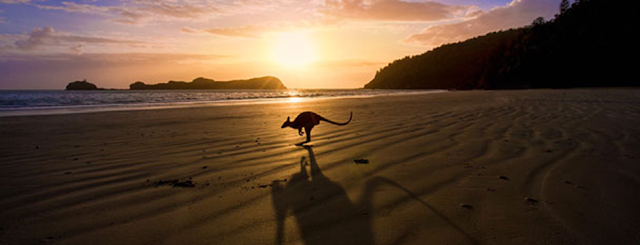A Dream of Cable Beach
Capturing
the power of the sea
My late Father spoke to me of the tides at
Cable Beach and said there must be a way to harvest the moving of the ocean to
generate power. He first saw Cable Beach near Broome during WWII. Over the
night the sea seemed to disappear and it came back.
The tides are huge at Cable Beach but
strategic globally.
Cable Beach – Tide out
Last night, at a
function sponsored by Invest HK, I met Dr Bruce Poon of Mako Tidal Turbines. Dr
Poon works in the design and manufacture of the next generation of turbines
which harvest energy from the movement of water based on tidal movements. What
Mako have been able to demonstrate that there is also energy which can be
captured from currents. Dr Poon’s explanation of his work in the area and the
global efforts made me read more. Perhaps the ocean and tide power was the next
big things that Projects RH (see: www.projectsrh.com.au)
in Australia and Tabatinga (see www.tabatingasg.com.au)
in Asia and Latin America should be focusing on? I must admit as Dr Poon spoke,
I was thinking of its application in the huge Colombian Pacific Port of
Buenaventura which is noticeably tidal and is in an area of Colombia needing
additional power.
Tidal energy is
generated broadly in the same way as hydroelectric power. It uses energy
generated by moving water to generate electricity. For me the simplicity of
tidal energy is available n the ocean, in estuaries, canals.[2]
Three thoughts are appealing:
1)
You do not need to build dams
and block rivers. You are not taking water from other purposes.
2)
The flow and timing are highly
predictable. The tidal cycle is two high and two low tides occur every 24 hours
and 50 minutes.
3)
The water does not need to be
pumped back after it has been used to generate power.[3]
4)
Turbines can be placed in
lines. [4]
Given about 70%
of the earth’s surface is water why do we not have vast arrays of turbines
collecting another valuable harvest from the sea? It was originally cost and
then perceived cost. Secondly, the real price of energy has risen and the cost
of capture of tidal energy has fallen with improved technology, design and new
materials
Because the
Earth's tides are ultimately due to gravitational interaction with the Sun and
the Moon coupled with the Earth's rotation, tidal power is practically
inexhaustible. The impact of large amounts of tidal power on tilt of the earth
and its rotation speed is negligible. Tidal power is rightly classified as a
renewable energy resource.
The three ways
commonly used to harvest tidal power are:
1)
Creating a tidal lagoon and
capturing the energy as the water enters and leaves the lagoon.
2)
Tidal barrages – specialised
dams with turbines
3)
Turbines attached to
infrastructure – channels, bridges etc.
Tidal power has
had enthusiastic supporters and investors in the 20th Century with
projects in US and Canada in the 1920’s and in 1960’s in France (Rance River
estuary in Brittany – 24 * 10 MW but delivering an average of 57MW.
The 21st
Century has seen renewed energy and investment in Europe and Asia. South
Korea’s Sihwa Lake Tidal Power Station, completed in 2011, is the world's
largest tidal power installation, with a total power output capacity of 254 MW
(but a 24.8% capacity factor due to running only one director for environmental
reasons).[5]
It is appropriate to see tidal power as a new form of renewable energy in the
21st Century as they application has substantially changed with
investors understanding that the capital and maintenance costs need to
controlled (reduced) and it needs to compete based on production being over 50%
of the time.
The outlook is
particularly rosy. There are some predictions that profitable prototypes could
be offered to the market in the early 2020’s.
What remains
attractive about tidal power is it is predictable and like solar low ongoing
cost. What is happening is that the designs are being simplified, capital costs
lowered and technical efficiency being improved.
The work being
undertaken by MAKO, and others, is seeing a tidal energy becoming able to
compete on a level playing field making it affordable to install as well as
profitable to invest in. What is pleasing for us to see is so much of the work
is occurring in Australia, Singapore and Japan - each od which is surrounded by
the great moving oceans.
By Paul Raftery (see www.paulraftery.com.au)
[1] Source: https://www.google.com/search?q=cable+beach+photo&tbm=isch&tbs=rimg:CbxlS-Zf0f0NIjjX2Wkyg-pIshNEj1sx3FPUX66D7z4QDmY2y2N2YdD3DosVA9uQvost0apSk7F5DqUTseJ8wTCZ4yoSCdfZaTKD6kiyEYLUJ5llafHNKhIJE0SPWzHcU9QRxyur0g_1NYCkqEglfroPvPhAOZhEaDgcSsSvfNCoSCTbLY3Zh0PcOEaBfiRC_1BOaUKhIJixUD25C-iy0RLwCOZCIQh7cqEgnRqlKTsXkOpRGKbIwJ0l6RuSoSCROx4nzBMJnjEYpsjAnSXpG5&tbo=u&sa=X&ved=2ahUKEwj7vOH1o7HiAhWDrI8KHQ20CkoQ9C96BAgBEBg&biw=1261&bih=895&dpr=1#imgrc=19lpMoPqSLJ0sM: Accessed 23-05-19
[3] In Australia the so called “national battery”, the Snowy Mountains
Hydro Scheme, can be called upon to supply power on demand. But to call it next
time the water needs to be pumped back by coal fired power units. The Genex (Kidston)
pump hydro project, in Central Queensland, uses solar power to pump its water
back.




Comments
Post a Comment